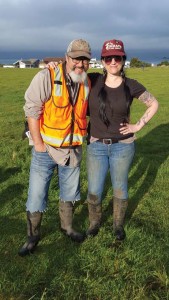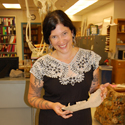Digging Jacksonville – September 2016
The Southern Oregon University Laboratory of Anthropology (SOULA) just returned from a month-long dig on the coast, investigating two sites associated with the Rogue River War of the mid-19th Century. This work is just part of a multi-year project that has taken us all over southwest Oregon, including Jacksonville. During the recent work installing new sidewalks along Main Street, we had an opportunity to do some excavation next to the Brunner Building—one of the oldest brick buildings in Oregon. As one would expect, this building has seen some things. Along with its many incarnations as store, auto shop, museum, library, and current use as a thrift store, the building is said to have played a role in the Rogue River War. Early 20th century local newspapers report that women and children fled to the Brunner Building for safety “when the Indians made their last raid on the white settlers in 1856.” The very walls of the brick building were said to have been “built at considerable expense…to withstand the frequent threatened attacks of the Indians, and the structure served the double purpose of a trading post and stockade.”
The 1850s in southern Oregon were indeed very violent. By May 1856, after years of conflict, most Native Americans from Southern Oregon were removed to reservations in northern Oregon by the U.S. Government. But did the war ever reach Jacksonville itself? Was the Brunner building built or used as a fortification? Jacksonville was settled in 1852, and Jacob Brunner and Henry Goldsmith acquired the land on the corner of Oregon and Main streets in 1853 from James Cluggage and Fred Furbay, and began construction of the brick building in 1855. Added on to over time, it is the oldest portion of the structure that survives to this day.
Our excavations did not reveal any traces of the earthen fortification or stockade. If this building was meant as a fortification, it relied on its brick architecture. Indeed, during the Indian Wars of southern Oregon, it was common for pioneers to ‘fort up’ at larger homesteads within communities for mutual protection. Such forts were found in Phoenix, Ashland, Sterling, Grants Pass, and elsewhere, and as the stories grew with the telling, often stockades and other embellishments were added. Such is likely the case for the Brunner building; in fact, in March 1856, as the war was winding down, early pioneer William T’Vault would call on the citizens of Jacksonville to build their own fort, stating that those seeking refuge in the town’s brick houses would surely “be smothered or be crushed to death by falling in of the walls when the Indians attacked.”
Contrary to local legend, our research leads us to believe that the Brunner building was only a simple brick store, as Jacksonville was never actually attached during the Rogue River War. Nonetheless, the building remains symbol of the travails of those pioneers, and the conflicts they perpetrated in gaining a foothold in southern Oregon.
Mark Tveskov is a Professor of Anthropology at Southern Oregon University and director of the Southern Oregon University Laboratory of Anthropology (SOULA).


 Chelsea Rose is an historical archaeologist who specializes in the settlement and development of the American West. Chelsea and the Southern Oregon University Laboratory of Anthropology (SOULA) conduct archaeology across Oregon and have done several projects in Jacksonville. You can reach Chelsea at rosec@sou.edu and follow SOULA on
Chelsea Rose is an historical archaeologist who specializes in the settlement and development of the American West. Chelsea and the Southern Oregon University Laboratory of Anthropology (SOULA) conduct archaeology across Oregon and have done several projects in Jacksonville. You can reach Chelsea at rosec@sou.edu and follow SOULA on